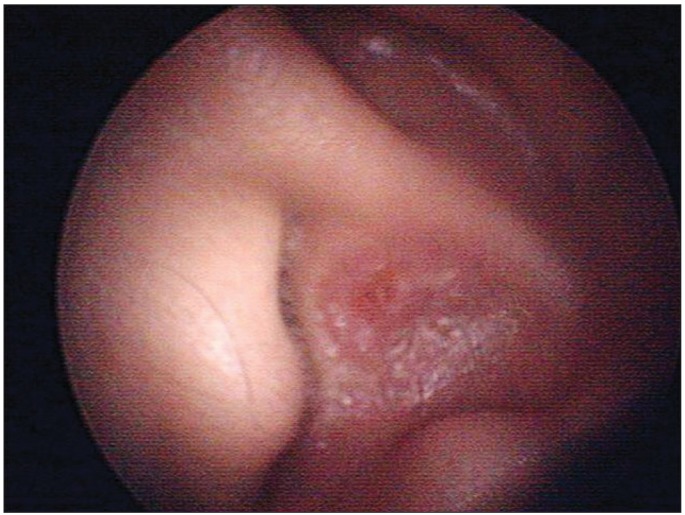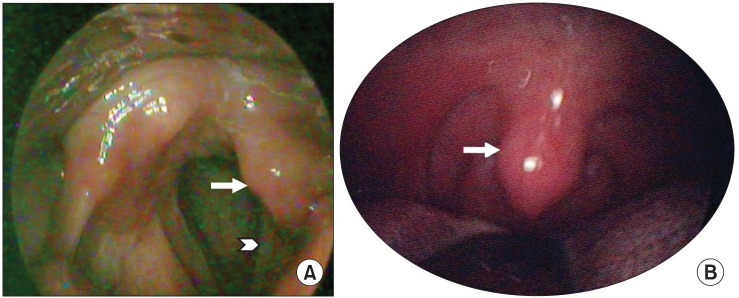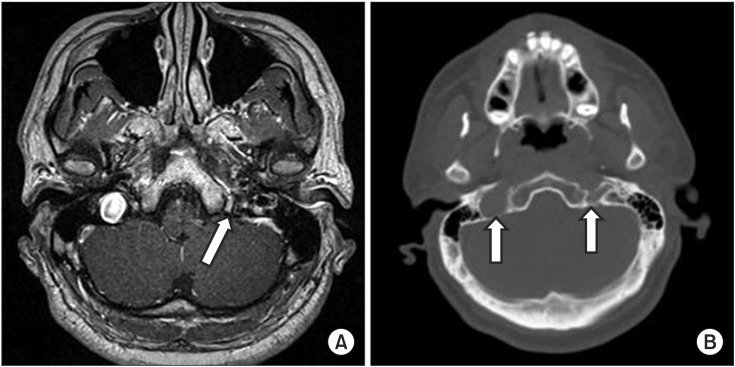Ann Rehabil Med.
2013 Jun;37(3):449-452. 10.5535/arm.2013.37.3.449.
Vernet Syndrome by Varicella-Zoster Virus
- Affiliations
-
- 1Department of Rehabilitation Medicine, Seoul St. Mary's Hospital, The Catholic University of Korea College of Medicine, Seoul, Korea. petitehj01@naver.com
- 2Department of Rehabilitation Medicine, Uijeongbu St. Mary's Hospital, The Catholic University of Korea College of Medicine, Uijeongbu, Korea.
- KMID: 2219546
- DOI: http://doi.org/10.5535/arm.2013.37.3.449
Abstract
- Vernet syndrome involves the IX, X, and XI cranial nerves and is most often attributable to malignancy, aneurysm or skull base fracture. Although there have been several reports on Vernet's syndrome caused by fracture and inflammation, cases related to varicella-zoster virus are rare and have not yet been reported in South Korea. A 32-year-old man, who complained of left ear pain, hoarse voice and swallowing difficulty for 5 days, presented at the emergency room. He showed vesicular skin lesions on the left auricle. On neurologic examination, his uvula was deviated to the right side, and weakness was detected in his left shoulder. Left vocal cord palsy was noted on laryngoscopy. Antibody levels to varicella-zoster virus were elevated in the serum. Electrodiagnostic studies showed findings compatible with left spinal accessory neuropathy. Based on these findings, he was diagnosed with Vernet syndrome, involving left cranial nerves, attributable to varicella-zoster virus.
Keyword
MeSH Terms
Figure
Reference
-
1. Robbins KT, Fenton RS. Jugular foramen syndrome. J Otolaryngol. 1980; 9:505–516. PMID: 7206037.2. Hunt JR. The symptom-complex of the acute posterior poliomyelitis of the geniculate, auditory, glossopharyngeal and pneumogastric ganglia. Arch Intern Med (Chic). 1910; 5:631–675.
Article3. Park JH, Park IS, Ha JS, Sim JH, Sul SY. Dysphagia associated with jugular foramen syndrome due to traumatic brain injury. J Korean Acad Rehabil Med. 2001; 25:163–167.4. Ha SW, Kim JK, Kang SJ, Kim MJ, Yoo BG, Kim KS, et al. A case of Vernet's syndrome caused by non-specific focal inflammation of the neck. J Korean Soc Clin Neurophysiol. 2007; 9:81–84.5. Brown H. Anatomy of the spinal accessory nerve plexus: relevance to head and neck cancer and atherosclerosis. Exp Biol Med (Maywood). 2002; 227:570–578. PMID: 12192098.6. Hashemilar M, Ghabili K, Shoja MM, Savadi-Oskouei D, Keyvani H. Varicella-zoster virus reactivation from multiple ganglia: a case report. J Med Case Rep. 2009; 3:9134. PMID: 19918290.
Article7. Kleinschmidt-DeMasters BK, Gilden DH. Varicellazoster virus infections of the nervous system: clinical and pathologic correlates. Arch Pathol Lab Med. 2001; 125:770–780. PMID: 11371229.8. Hayashi T, Murayama S, Sakurai M, Kanazawa I. Jugular foramen syndrome caused by varicella zoster virus infection in a patient with ipsilateral hypoplasia of the jugular foramen. J Neurol Sci. 2000; 172:70–72. PMID: 10620663.
Article9. Kawabe K, Sekine T, Murata K, Sato R, Aoyagi J, Kawase Y, et al. A case of Vernet syndrome with varicella zoster virus infection. J Neurol Sci. 2008; 270:209–210. PMID: 18456282.
Article10. Gejrot T. Jugular syndrome. Acta Otolaryngol. 1964; 57:450–458. PMID: 14153749.
- Full Text Links
- Actions
-
Cited
- CITED
-
- Close
- Share
- Similar articles
-
- A Case of Vernet Syndrome due to Varicella Zoster Virus Infection with Skin Lesion Induced by Cervical Segment Involvement
- Herpes zoster complicated by deep vein thrombosis : a case report
- Two cases of varicella zoster meningitis in immunocompetent children
- Association of Herpes Zoster and Lymphosarcoma: Report of one Case
- A clinical study on varicella zoster virus infection and treatment in children with malignant lymphoproliferative disease




